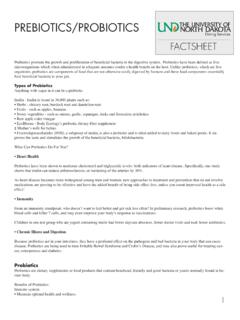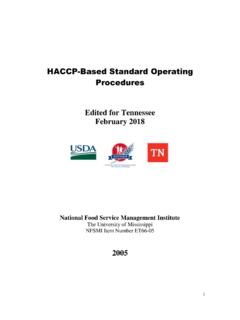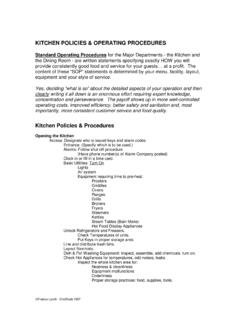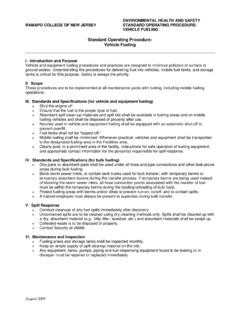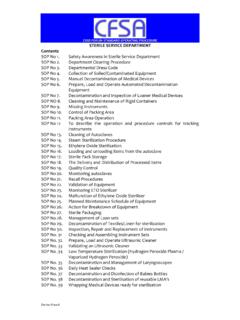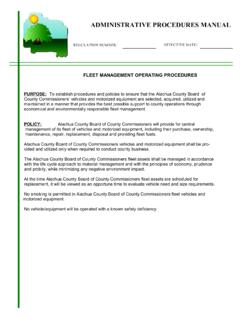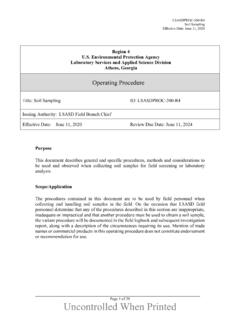Transcription of Sanitation & Food Safety Standard Operating Procedure …
1 Sanitation & Food Safety Standard Operating Procedure Manual HACCP- Based Standard Operating procedures Revised July 3rd, 2018. HACCP-Based Standard Operating procedures (Return to Table of Contents). Table of Contents 1. Employee Sanitation standards A. Personal Hygiene ..4. B. Hands Washing & Hand Washing ..6. C. Glove & Utensil Use When Handling Ready-to-Eat Foods ..8. D. Employee Uniforms ..10. E. Eating, Drinking, Taste Testing, & Breaks/Meals .13. F. Employee Smoking/Tobacco Use ..15. G. Employee Dressing Rooms 17. H. Cuts, Burns or Lesions on Lower Arms or Hands ..19. I. Contact with Blood & Bodily Fluids .21. J. Employee Illness.
2 23. 2. Storage & Receiving A. standards for Receiving Food Central Foods Warehouse. 26. B. standards for Receiving Food All other Dining 29. C. Handling Rejected Food 33. D. Measuring Temperatures of Food Upon Receipt..36. E. Proper Training for Employees Who Store Food ..38. F. FIFO (First In, First Out) Stock 40. G. standards for Dry Storage ..42. H. standards for Cooler Storage .44. I. standards for Freezer Storage 46. J. standards for Bread Storage ..48. K. Corrective Action for Cooler & Freezer Temperatures .50. 3. Food Production A. Controlling Time & Temperature During 52. B. Acceptable Thawing .54. C. Using & Calibrating Thermometers.
3 56. D. Date Marking & Ready to Eat (TCS) Food ..58. E. Washing Fruits & Vegetables 60. F. Cooking (TCS) Foods ..62. G. Cooling (TCS) Foods ..65. H. Holding Hot and Cold (TCS) I. Reheating (TCS) Foods ..70. J. standards for Deli Foods & Salad Bars .72. JA. Deli Meats & Cheeses ..74. K. Food Production Sinks ..78. ii HACCP-Based Standard Operating procedures (Return to Table of Contents). 4. Food Safety A. Preventing Cross Contamination During Storage & Preparation ..80. B. Removing Food from the 82. C. Transporting Food to Remote Sites (Satellite Kitchens) ..84. D. Unattended Food..87. E. Serving Food .89. F. Temperature Logs for the Serving Areas.
4 91. G. Acceptable Use of Leftovers .93. H. Handling a Food Recall .95. 5. Cleaning & Sanitation A. Employee Training on Sanitation ..97. B. Storing & Using Poisonous or Toxic Chemicals ..99. C. Cleaning & Sanitizing Food Contact Surfaces 101. D. Dish Room Standard Operating procedures 105. E. Floor Maintenance ..110. F. Proper Storing of Equipment & Utensils .112. G. Emptying of Garbage Receptacles..116. H. Prevention of Vermin or Insect Infestation .118. I. Sanitation Inspections ..120. 6. Incident Reports A. Incident Reports ..122. 7. Employee Alcohol & Drug Policy A. Alcohol & Drug Prohibition ..124. 8. Sanitation & Food Safety Standard Operating Procedure Annual Training A.
5 Sanitation & Food Safety B. Standard Operating Procedure Annual Training . 130. iii HACCP-Based Standard Operating procedures (Return to Table of Contents). 1A: Personal Hygiene PURPOSE: To prevent contamination of food by foodservice employees. SCOPE: This Procedure applies to foodservice employees who handle, prepare, or serve food. KEY WORDS: Personal Hygiene, Cross-Contamination, Contamination INSTRUCTIONS: 1. Train foodservice employees on using the procedures in this SOP. 2. Follow 2013 Grand Forks County Food Code Section General Personal Cleanliness 33-33- 04-29. 3. Follow the Employee Illness SOP. 4. Report to work in good health, clean, and dressed in clean attire.
6 5. Change apron when it becomes soiled. 6. Wash hands properly, frequently, and at the appropriate times. 7. Fingernails are to be kept short and clean. No nail polish is allowed. No artificial nails are permitted in the food production area. 8. Keep hair clean and wear approved hair/beard restraints ( hairnets, or a UND issued hat), while working in the food preparation or serving areas. 9. Bathe daily and wear acceptable amount of fragrance. 10. The only jewelry that may be worn while working in the food preparation or service areas is wedding bands. No dangling jewelry or watches are allowed. 11. No jewelry from visible piercings such as ears, lip, nose, eyebrow, tongue, etc.
7 Is to be worn during shift. 12. Report any illness to the manager on duty. 4. HACCP-Based Standard Operating procedures (Return to Table of Contents). 1A: Personal Hygiene, continued MONITORING: 1. A direct supervisor will inspect employees when they report to work to be sure that each employee is following this SOP. 2. The direct supervisor will monitor that all foodservice employees are adhering to the above stated employee policy during all hours of operation. CORRECTIVE ACTION: 1. Retrain any foodservice employee found not following the procedures in this SOP. 2. Discard affected food. VERIFICATION AND RECORD KEEPING: The direct supervisor will verify that foodservice employees are following this SOP by visually observing the employees during all hours of operation.
8 The direct supervisor will complete the Food Safety Checklist daily. The Food Safety Checklist is to be kept on file for a minimum of 6. months. DATE IMPLEMENTED: _____ BY: _____. DATE REVIEWED: _____ BY: _____. DATE REVISED: _____ BY: _____. 5. HACCP-Based Standard Operating procedures (Return to Table of Contents). 1B: Hand Washing & Hand Washing Sinks PURPOSE: To prevent foodborne illness by contaminated hands. SCOPE: This Procedure applies to anyone who handles, prepare, and serve food. KEY WORDS: Hand washing, Cross-Contamination INSTRUCTIONS: 1. Train foodservice employees on using the procedures in this SOP. 2. Follow 2013 Grand Forks County Food Code Section General Personal Cleanliness 33-33- 04-29.
9 3. Post hand washing signs or posters in a language understood by all foodservice staff near all hand washing sinks, in food preparation areas, and restrooms. 4. Use designated hand washing sinks for hand washing only. Do not use food preparation, utility, and dishwashing sinks for hand washing. 5. Provide warm running water, soap, and a means to dry hands. Provide a waste container at each hand washing sink or near the door in restrooms. 6. Keep hands washing sinks accessible anytime employees are present. 7. Wash hands: Before starting work During food preparation When moving from one food preparation area to another Before putting on or changing gloves After using the restroom After sneezing, coughing, or using a handkerchief or tissue After touching hair, face, or body After touching clothing, shoes, or aprons.
10 After smoking, eating, drinking, or chewing gum or tobacco After handling raw meats, poultry, or fish After any clean up activity such as sweeping, mopping, or wiping counters After handling chemicals which could affect food Safety . After touching dirty dishes, equipment, or utensils After handling trash After handling money After any time the hands may become contaminated 6. HACCP-Based Standard Operating procedures (Return to Table of Contents). 1B: Hand Washing & Hand Washing Sinks, continued 8. Follow proper hand washing procedures as indicated below: Wet hands and forearms with warm, running water at least 100 F and apply soap.





